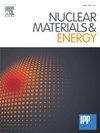SOLPS-ITER simulations of the ITER divertor with improved plasma-facing component geometry
IF 2.3
2区 物理与天体物理
Q1 NUCLEAR SCIENCE & TECHNOLOGY
引用次数: 0
Abstract
The ITER divertor design has been guided by SOLPS4.3 plasma boundary code simulations focused on baseline burning conditions at QDT = 10 which compose the majority of the existing ITER divertor scenario database. An effort is now underway, the first results of which are described here, to extend this database with improved SOLPS-ITER simulations adopting a newly implemented Grad-Zhdanov closure, the latest magnetic equilibrium featuring optimized wall clearances compared to that used in the original database, and a much higher fidelity model of the divertor structure, permitting a more realistic accounting of bypass conductances for neutrals around the divertor cassette body.
This paper focuses on the first throughput scan conducted for burning plasma conditions with 100 MW of power coming to the scape-off layer (SOL) and feedback controlled neon (Ne) seeding. The simulations show that the neutral gas reservoir “stored” underneath the divertor cassette is about a factor 10 higher than the number of main plasma nuclei in the SOL region. As a result, a strong neutral recirculation loop develops between the private flux region and the far-SOL via pathways around the divertor cassette body under high recycling conditions and is very effective at increasing dissipation in the far-SOL compared to the conventional SOLPS-ITER simulations with sub-divertor fueling at the same neutral pressure (pn) underneath the dome. This leads to a drastic reduction of plasma temperature in front of the target plates in the far-SOL, eliminating any concern of tungsten sputtering from the divertor under stationary conditions at pn sufficient to achieve peak heat flux mitigation. Since the pumping duct resides beneath the cassette body and is less accessible for neutrals entering the sub-divertor space, increasing the fidelity of the divertor structure model leads to a decrease of the pressure at the pumping duct for a given pn. This in turn decreases both the fueling throughput required to maintain pn at a given level and the helium (He) pumping efficiency, with the result that the upstream separatrix He concentration increases by several factors.
However, the simulations with higher fidelity description of the divertor using Monte-Carlo neutrals are extremely time consuming and hence cannot be routinely used despite the pronounced effect on the solution. A solution to this would be the development of a reduced model guided by a reasonably large database of simulations with a higher fidelity description of the divertor that would link the far-SOL fluxes to the private flux region (PFR) conditions.
求助全文
约1分钟内获得全文
求助全文
来源期刊

Nuclear Materials and Energy
Materials Science-Materials Science (miscellaneous)
CiteScore
3.70
自引率
15.40%
发文量
175
审稿时长
20 weeks
期刊介绍:
The open-access journal Nuclear Materials and Energy is devoted to the growing field of research for material application in the production of nuclear energy. Nuclear Materials and Energy publishes original research articles of up to 6 pages in length.
 求助内容:
求助内容: 应助结果提醒方式:
应助结果提醒方式:


